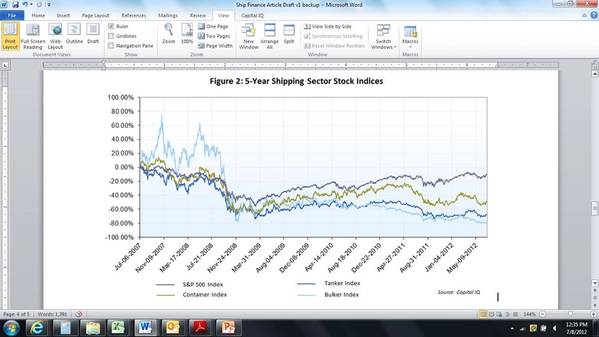
In recent years, excess vessel capacity has been plaguing shipping markets and the resultant drop in asset values has restrained financing options for ship owners.
Following the financial crisis in 2008, demand across the major shipping segments – dry bulk, tanker and container – has slowly returned, though on an unsteady and often unpredictable path. Increased ton-mile demand (and continued slow steaming) should drive increased charter and spot rates, but the recent recovery in demand has been overshadowed by the vast oversupply of newbuilds delivering into the market, which has kept revenues and earnings too low to cultivate a sustainable recovery.
Shipping is a cyclical business, highly sensitive to world macroeconomic changes and marked by amplified boom and bust periods. In the 1970’s, the industry as a whole experienced two peaks that corresponded with two major oil crises, followed by a prolonged depression in the sector during the 80’s. The 1990’s were a bit more stable after an early bust in 1993, but experienced the Asian contagion by the end of the decade. A historic surge of demand driven by developing economies in the 2000’s brought a huge boom and the Clarksea weighted index of shipping rates topped $46,000 per day in 2008, up from just $12,000 a day at the beginning of the decade. It was this positive cycle late in the last decade that generated excessive new ship orders and caused the current capacity glut after the global downturn in 2008.
In past shipping recoveries, newbuild deliveries were at reasonable levels at or below 6% of global fleet capacity, so charter rates and utilization levels rebounded nicely. After the recent financial crisis and trade recession that brought the Clarksea Index back down to pre-boom levels, however, shipyard output remained strong. According to the 2012 Platou Report, scheduled newbuild deliveries still exceed 11% of existing fleet capacity this year following total fleet growth of 8.2% in 2011. Coupled with anemic world GDP growth, this unprecedented fleet expansion has kept continued downward pressure on charter rates.
The combination of uncertain markets, a tight credit market and the oversupply of vessels has cast a gloom over the shipbuilding industry. Though deliveries continue at a fairly strong rate this year, most shipyards are on course for lean years beginning in 2013. By various estimates, secondhand ship values have dropped as much as 70% while the cost of newbuilds in Asia has fallen by 30-50%. From a high of more than 260 million deadweight tons ordered in 2007, worldwide orders dropped to about 60 million dwt in 2011.
Shipping is a unique industry that remains dominated by private, often family-owned companies with a long history in the business. Banking relationships tend to be long-term partnerships, with debt remaining closely held primarily by European banks. At the peak of the shipping boom in period of 2006-2008, a large number of newbuild and existing ships were financed at high market prices with aggressive capital structures and loose financial covenants. The equity capital markets were booming (Figure 1) and, in combination with the abundance of debt financing on favorable terms, this allowed owners to place big speculative bets that many later came to regret.
As the predominant suppliers of debt financing to the global shipping industry, European banks now have an estimated $500 Billion in outstanding loans, with ~$230 Billion on the balance sheets of the top ten shipping lenders alone. These banks have also been greatly impacted by the European debt crisis and the regulatory changes implemented by Basel III. Whereas these banks may have access to their national currency (whether EUR, GBP, SFr or NOK) at fairly competitive borrowing rates, they have substantially higher borrowing costs in USD, the standard currency in the global shipping industry.
Basel III has the added effect of requiring banks to set aside a larger percentage of regulatory capital against their loan books, as well as to match fund the term of their loan commitments. A critical impact of Basel III will be that the banks will have to apply more capital to their existing loan portfolios and therefore have less capital available to make new loans. The match funding issue means that banks have to price their actual USD term liquidity costs into the margins that they charge over Libor. Libor funding is a shorter term financing market and does not match the term funding commitment provided by lenders.
Several high profile banks have decided to reduce their exposure to USD funding needs and have decided to exit ship lending entirely, leaving some unanswered questions. Other banks have scaled back their ambitions and are only there to support their existing customer base. The global shipping industry requires substantial equity and debt capital to take delivery of the existing orderbook of vessels and refinance debt facilities as balloon payments become due. Where will this money come from?
Though Private Equity firms have shown an interest in shipping companies and assets recently, there is certainly no clear path for them to get guaranteed returns of 25% (preferably risk-free) based upon current ship values and charter rates. A few PE firms have actually stepped up and made investments but the jury is still out as to whether more will follow.
To entice new orders, shipyards have significantly lowered contract prices and are offering attractive payment terms. The stronger shipyards appear to have a degree of financial support from their domestic export credit agencies (ECAs) which have stepped up their efforts and have been generally supportive of their own domestic shipbuilding industry. The ECAs will support their domestic shipyards by financing the shipyards’ working capital needs that are heightened by the heavy tail payments at delivery.
Most shipowners are having a difficult time raising pre- and post-delivery financing for newbuilds from the lenders who have remained open for business. But with shipyards reportedly only requiring a total of 20-30% in payments prior to delivery, shipowners interested in placing orders today can effectively fund these payments with equity. The ECAs have stepped up and can either provide post-delivery loans directly to the shipowner or guarantee that the principal and interest on the ship loan is repaid in the event of a default by the shipowner. ECAs are active but are unlikely to be able to fill the void left by the exodus of lenders from the ship finance industry.
Will the ECAs, Asian banks and US banks fill the void left by the departing European lenders? As long as the global shipping markets remain a USD industry, it will be hard for the ECAs and Asian banks to fill a major portion of the impending funding gap as they too have USD funding issues. They will likely play a bigger role in providing ship financing going forward but will not solve the looming debt shortage. The big US money center banks could get more involved provided that the margins are high enough to earn attractive risk adjusted returns. These banks are mainly yield driven and have full access to USD funding but will only be interested if the yields that they can achieve are attractive relative to the rates they can charge for alternative deals in other industries.
Finally, will a market develop for structured shipping debt products such as securitization or covered bonds? Investors who might buy this paper would require rating agencies to assign investment grade ratings to shipping assets which may be a real stretch given that the rating agencies are not fans of the volatility in ship values and earnings.
Despite the numerous troubles in shipping and ship finance, there are some bright spots. Specialized niches such as LNG carriers and offshore energy operators are thriving. Available LNG carriers are earning record rates in today’s market. Recent General Rate Increases (GRI’s) on certain containership routes have shown success, and overall global trade is expected to grow at a rapid rate over the next 15 years. The rapid taper in newbuild orders, though troublesome for shipyards, should also bring capacity utilization and charter rates back in line over time. And though financing remains tight in the sector, the overall low cost of capital and bottoming asset prices will create opportunities for bold investors to invest in ships and carry out mergers and acquisitions in the next few years.
Carl Rasmussen is a Senior Vice President / Senior Relationship Manager at HSH Nordbank AG in New York, one of the world’s leading financial service providers to the global shipping industry. He is responsible for new deal origination and managing client relationships with shipping companies based in the Americas. He is a US Merchant Marine Academy graduate and earned an MBA from Tulane University.
Harry Ward leads the transportation and logistics practice at The McLean Group, a middle-market investment bank based in the Washington, DC area. Mr. Ward has executive management experience in the marine industry and focuses on mergers and acquisitions for mid-sized companies. He is a US Naval Academy graduate and earned an MBA at San Diego State University.
+ (Published in the 3Q 2012 print edition of Maritime Professional magazine - www.maritimeprofessional.com) +


